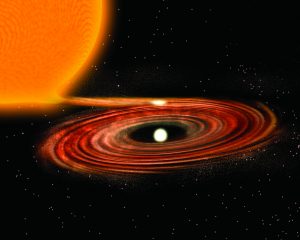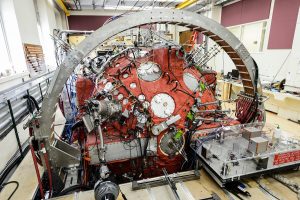Stars, solar systems, and even entire galaxies form when astrophysical plasma — the flowing, molten mix of ions and electrons that makes up 99% of the universe — orbits around a dense object and attaches, or accretes, on to it. Physicists have developed models to explain the dynamics of this process, but in the absence of sending probes to developing stars, the experimental confirmation has been hard to come by.
In a study published in Physical Review Letters September 25, University of Wisconsin–Madison physicists recreated an astrophysical plasma in the lab, allowing them to investigate the plasma dynamics that explain the accretion disk formation. They found that electrons, not the momentum-carrying ions, dominate the magnetic field dynamics in less dense plasmas, a broad category that includes nearly all laboratory astrophysical plasma experiments.

Like water swirling around and down an open drain, plasma in an accretion disk spins faster nearer the heavy object in the center than further away. As the plasma falls inward, it loses angular momentum. A basic physics principle says that angular momentum needs to be conserved, so the faster rotating plasma must be transferring its momentum away from the center.
“This is an outstanding problem in astrophysics — how does that angular momentum get transported in an accretion disk?” says Ken Flanagan, a postdoctoral researcher with the department of physics at UW–Madison and lead author of the study.
The simplest explanation is friction, but it was ruled out when the corresponding accretion times, in some cases, would be longer than the age of the universe. A model developed by theoretical physicists posits that turbulence, or the chaotic changes in plasma flow speeds, can explain the phenomenon on a more realistic time scale.
“So ad hoc, astrophysicists say, ‘Okay, there’s this much turbulence and that explains it,’” Flanagan says. “Which is good, but you need to call in the plasma physicists to piece together where that turbulence comes from.”
Flanagan and colleagues, including UW–Madison physics professor Cary Forest, wanted to build off an idea that the turbulence was coming from an intrinsic property of some plasmas known as magnetorotational instability. This instability is seen in plasmas that are flowing fastest near the center and are in the presence of a weak magnetic field.
“And it’s lucky because there are weak magnetic fields all around the universe, and the flow profile in the accretion disks is set by the gravitational force,” Flanagan says. “So, we thought this plasma instability could be responsible for turbulence, and it explains how accretion disks work.”
To investigate if this intrinsic plasma instability explained the observation, the researchers turned to the Big Red Ball (BRB), a three-meter-wide hollow sphere with a 3000 magnets at its inner surface and various probes inside. They activate a plasma by ionizing gas inside the BRB, then applying a current to drive its movement.

Because they had previously been encountering problems in driving very fast flows, they tried a new technique to drive the flow across the entire volume of plasma, as opposed to just the edges. Fortuitously, the BRB had magnetic field probes from a previous experiment still attached, and when they activated the plasma under these conditions, they found that this new flow setup amplified the magnetic field strength with a peak at the center nearly twenty times the baseline strength.
“We didn’t expect to see that at all, because usually in plasma physics the simplest model is to think of plasmas as one fluid with the heavier ions dominating momentum,” Flanagan says. “The results suggested that the plasma is in the Hall regime, which means the electrons and their motion are entirely responsible for the plasma moving around magnetic fields.”
If they were correct in assuming it was the Hall effect that was driving magnetic field amplification, the equations governing magnetic fields and electric currents say that if you drive the current in the opposite direction, the strength of the magnetic field would be canceled out. So, they switched the current and measured the magnetic field strength: it was zero, supporting the Hall regime explanation.
While the results are not directly applicable to the plasma accretion disks around, say, a very dense black hole, they do directly impact the earth-bound experiments that attempt to recreate and study them.
“Nearly all plasma astrophysical experiments operate in the Hall regime, and so this sort of large qualitative effect is something you’re going to have to pay attention to when you make these sorts of flows in laboratory astrophysical plasmas,” Flanagan says. “In that sense, this work has a pretty broad impact for lots of different research areas.”
This research was supported in part by the National Science Foundation (#1518115) and by the U.S. Department of Energy (#DE-SC0018266).